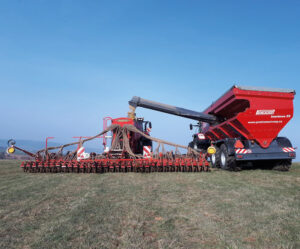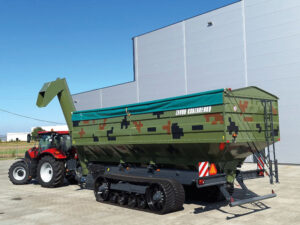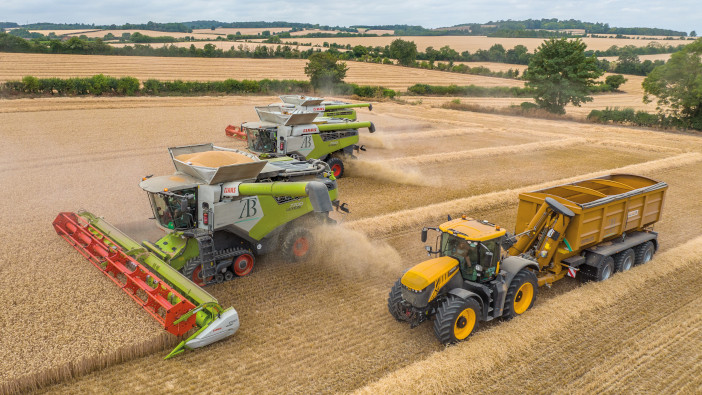While still a niche in the UK, chaser bins are a key part of the harvesting process in North America and those benefits could easily transfer here as the industry changes
This year notwithstanding, harvest is typically an intense time with tight weather windows and additional staff brought in to haul trailers and make sure that the combine never stops.
This latter point is important for two reasons: firstly, inexperienced staff may be unaware of the need to remain on tramlines where possible to minimise compaction and may also be unable to follow alongside the combine during emptying; secondly, as farms continue to increase in size, the distance between the field and the yard has naturally increased with this. Unless there are multiple stores to hold grain, it means that more trailers are required to ensure the combine keeps moving.
Depending on the distance, some may even consider articulated lorries to haul from the field to the farm. These can be specified to run on fields, with agricultural tyres, but, like with large-scale slurry and digestate operations, it makes more sense to load them on the road where possible.
According to Agri Industry Solutions (AIS), there has been continued interest in the Perand Interbenne range of grain chaser bins for this exact reason. It features an unloading auger that can be operated at any point within its range of travel, and has a maximum reach of 5m, with a 5m unloading height, meaning it is suitable for unloading over a hedge or ditch into a vehicle on the road.
As an option, it’s possible to fit the auger with a remote control system and a downpipe, meaning it can also be used for filling implements on the farm, including drills and fertiliser spreaders. AIS notes that this increases the versatility of the unit and can help to justify the cost.
 It can also act as an effect buffer between the combines and the trailers, with capacities running from 30cu m up to 52cu m. This means it can hold a full tank from even the largest harvesters, so if transport trailers are taking longer than expected, the combine can always keep moving.
It can also act as an effect buffer between the combines and the trailers, with capacities running from 30cu m up to 52cu m. This means it can hold a full tank from even the largest harvesters, so if transport trailers are taking longer than expected, the combine can always keep moving.
For those concerned about soil compaction, Perand also offers the X-Flow series of machines with a more traditional auger system. This is purely designed for carrying grain until trailers are available, offering capacities from 15cu m up to a huge 71cu m.
Investing to maximise investments
Martin Jenson, of Kobzarenko, directly links the interest in chaser bins to the growing use of trucks within agriculture and the higher capital cost required for a new combine harvester.
“The demand for chaser bins is driven by needs and economy. With new combine harvester prices regularly above £500,000, then even a few percentage points of extra efficiency gained with the use of a chaser bin warrants an investment to achieve critical logistics on the same occasion.
“The same applies to transport. If you can move grain off the field by truck at £7/t it leads to big capital cost savings in not having to kit out a fleet of tractor and trailer combinations at £100,000 apiece.”
Another consideration is the use of controlled traffic farming. Kobzarenko machines have capacities from 9cu m up to 50cu m, with up to four axles and the option of tracks. These capacities enable the units to run on adjacent tramlines (depending on the combine auger length), keeping machine weight in the correct place on the field.
 Recognising the high level of investment that a chaser bin requires, Kobzarenko has also made efforts to increase the overall versatility of the units. An auger conversion kit is available, with a 5m, 150mm diameter extension that makes the machine suitable for filling seed drills or fertiliser spreaders.
Recognising the high level of investment that a chaser bin requires, Kobzarenko has also made efforts to increase the overall versatility of the units. An auger conversion kit is available, with a 5m, 150mm diameter extension that makes the machine suitable for filling seed drills or fertiliser spreaders.
Martin notes that when used in these circumstances, the chaser bin offers the same logistical benefits of taking commodities from the field, speeding up large-scale operations.
British-built chasers
Richard Western has offered chaser bins in the UK for several years now, with three models available from 20cu m up to 38.5cu m. The two smallest (small in this context at least) machines are mounted on tandem running gear with a rear steering axle, while the largest is triple axles with front and rear steering.
Each model uses a front-mounted auger with variable height and reach to increase flexibility when unloading, as well as a hydraulically controlled chute tip for even loading of trailers.
An interesting point about the use of chaser bins is not just the ability to reduce temporary staff bought in at harvest, but also to redistribute staff to other tasks.
Harvest is frequently an all-hands-on-deck scenario, the culmination of nearly a year’s work. However, with weather windows getting tighter and the weather being unpredictable, having additional staff capacity to start ground preparation directly behind the combine could help to ease bottlenecks in the system.
If you can significantly reduce the number of trailers running to and from the combine harvest (each setup costing the aforementioned £100,000 apiece), then the cost of a chaser bin starts to look more appealing.
It requires a larger tractor upfront to handle the weight being towed, so running costs may be higher than a tractor/trailer combination, but there are plenty of scenarios where large tractors are used for haulage out of necessity.


